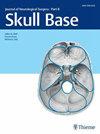三叉神经痛微血管减压中胸膜上结节切除手术的细微差别和预测因素
IF 0.9
4区 医学
Q3 Medicine
引用次数: 0
摘要
目的:报道了三叉神经痛(TN)微血管减压(MVD)术中胸膜上结节(SMT)是一个位于内耳道上方的骨突出物,它阻碍了显微镜观察。对于扩大的SMT,除了常规MVD外,可能还需要去除SMT以精确定位病变血管。本研究的目的是探讨影响三叉动脉MVD时SMT切除需求的预测因素。方法:我们回顾性分析197例因TN行MVD的患者,并分析SMT高度和其他临床手术数据与MVD期间移除SMT的必要性的相关性。统计分析中评估的参数包括最大SMT高度、患者临床特征、手术数据(包括病变血管的类型和数量)以及手术结果。结果:共纳入197例患者,其中20例患者需要SMT切除。在单变量分析中,最大SMT高度、患者年龄和问题血管数量(≥2)与SMT移除需求相关。多因素二元logistic回归分析显示,最大SMT高度和罪过血管数量(≥2)是影响SMT移除必要性的重要因素。接受者工作特征曲线分析显示,SMT高度≥4.8 mm是预测SMT移除需求的最佳截止值。结论:大的SMT和多支病变血管的存在有助于预测与SMT切除必要性相关的三叉动脉MVD的技术难度。本文章由计算机程序翻译,如有差异,请以英文原文为准。
Surgical nuances and predictors of requirement for suprameatal tubercle removal in microvascular decompression for trigeminal neuralgia
Objective: Suprameatal tubercle (SMT), a bony prominence located above the internal acoustic meatus, is reported to impede the microscopic view during microvascular decompression (MVD) for trigeminal neuralgia (TN). For an enlarged SMT, removal of the SMT may be required in addition to the routine MVD to precisely localize the offending vessels. The objective of this study is to investigate the predictive factors influencing the requirement of SMT removal during trigeminal MVD. Methods: We retrospectively reviewed 197 patients who underwent MVD for TN, and analyzed the correlation of the SMT height and other clinico-surgical data with the necessity to remove the SMT during MVD. The parameters evaluated in the statistical analyses included maximum SMT height, patient clinical characteristics, surgical data including the type and number of offending vessels, and surgical outcomes. Results: SMT removal was required for 20 patients among a total of enrolled 197 patients. In the univariate analysis, maximum SMT height, patient age, and number (≥ 2) of offending vessels were associated with the requirement for SMT removal. Multivariate analysis with binary logistic regression revealed that the maximum SMT height and number (≥ 2) of offending vessels were significant factors influencing the necessity for SMT removal. A receiver operating characteristic curve analysis revealed that an SMT height ≥ 4.8 mm was the optimal cut-off value for predicting the need for SMT removal. Conclusions: Large SMTs and the presence of multiple offending vessels are helpful in predicting the technical difficulty of trigeminal MVD associated with the necessity of SMT removal.
求助全文
通过发布文献求助,成功后即可免费获取论文全文。
去求助
来源期刊

Journal of Neurological Surgery Part B: Skull Base
CLINICAL NEUROLOGY-SURGERY
CiteScore
2.20
自引率
0.00%
发文量
516
期刊介绍:
The Journal of Neurological Surgery Part B: Skull Base (JNLS B) is a major publication from the world''s leading publisher in neurosurgery. JNLS B currently serves as the official organ of several national and international neurosurgery and skull base societies.
JNLS B is a peer-reviewed journal publishing original research, review articles, and technical notes covering all aspects of neurological surgery. The focus of JNLS B includes microsurgery as well as the latest minimally invasive techniques, such as stereotactic-guided surgery, endoscopy, and endovascular procedures. JNLS B is devoted to the techniques and procedures of skull base surgery.
 求助内容:
求助内容: 应助结果提醒方式:
应助结果提醒方式:


